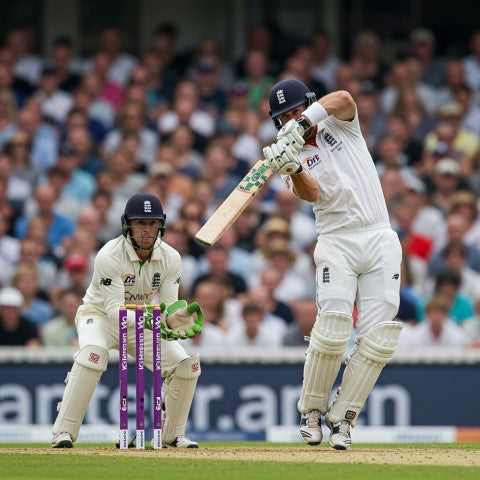Dinesh Karthik: The Veteran Who Redefined Impact in the 2025 IPL

The Indian Premier League has always been a crucible for narratives — from the rise of raw talent to the spectacle of fading legends refusing to fade quietly. In a tournament where every over is dissected and every innings scrutinised, there is little room for sentiment. And yet, in IPL 2025, one storyline managed to sneak in through sheer force of performance rather than nostalgia. Dinesh Karthik, at 39, not only found himself back in the thick of T20 action but reasserted his relevance with every composed finish and late-over flourish.
This wasn’t the quiet swan song many had predicted for him. Nor was it a ceremonial lap handed to a player for services rendered. What unfolded instead was a campaign that combined experience with execution, emotional control with technical clarity. Karthik’s innings weren’t loud, but they were timely. His shot selection wasn’t flamboyant, but it was surgical. And in a season marked by chaos — captaincy reshuffles, last-ball thrillers, injury dramas — his composure was a tactical asset for Royal Challengers Bengaluru.
In this article, we dissect his journey through IPL 2025, not as a retrospective eulogy, but as a study in high-level adaptation. We begin with how Karthik became the heartbeat of RCB’s late-innings charge, then explore the match situations that magnified his value. The following sections will examine his influence on team dynamics, the rejuvenation of his career, and the legacy he may leave in the shortest format. This was not the year of farewells; this was the year of reaffirmation.
1. Consistency Amid Chaos: Karthik’s Role in RCB’s Tactical Set-up
RCB’s 2025 campaign was characterised by one trait they’ve long lacked — tactical clarity. And a key beneficiary of that clarity was Dinesh Karthik, whose position as a designated finisher was both defined and protected. Far from floating up and down the order, Karthik was given a very specific assignment: close out innings from overs 15 to 20, with minimal fuss and maximum impact. And he delivered, not as a peripheral luxury, but as a functional core of the batting strategy.
Let’s look at the numbers: 11 innings, 9 not-outs, SR 169.3, and an average north of 53. What’s even more telling is his boundary percentage in the final three overs — 42%, putting him ahead of more celebrated finishers like Hardik Pandya and Shimron Hetmyer this season. Yet, the numbers only begin to tell the story. It was his decision-making under pressure that truly elevated him.
In a key clash against Rajasthan Royals, RCB found themselves in deep trouble at 124/5 after 15 overs, chasing 168. With dew settling in and the pitch offering grip, Karthik took stock. His 42* off 17 wasn’t just brutal — it was intelligent. He targeted bowlers selectively, manipulated the field using subtle changes in angle, and ensured the chase never spiralled into panic. Boult’s over was negotiated. Avesh was dismantled. The calm between those extremes was Karthik’s hallmark.
There’s something ironic about how T20 — a format synonymous with youthful athleticism — sometimes ends up rewarding cerebral cricketers in their twilight years. Karthik didn’t out-muscle bowlers; he out-thought them. That level of clarity isn’t taught in nets. It’s earned through years of mishits, misjudgements, and learning exactly which risks are worth taking when there are five balls left and two boundaries needed.
But perhaps his greatest gift to RCB wasn’t runs alone. It was dependability. In a season where middle orders across franchises crumbled under the weight of experimentation, Karthik gave RCB a rare constant: a finisher who understood his job, embraced its limitations, and executed with almost clinical detachment.
2. Match-Winning Moments: The Innings That Changed Games
While consistency builds a narrative, it's the moments that cement legacies. Karthik's 2025 season wasn't merely about ticking boxes — it was about tilting matches on their axis, often without fanfare. Whether batting first or chasing, his interventions were timely and cold-blooded, always tuned to the rhythm of the match rather than personal milestones.
Take the match against Chennai Super Kings — a derby always soaked in emotion, and one where RCB had often come undone. Walking in at 135/4 in the 15th over, Karthik faced an in-form Matheesha Pathirana bowling thunderbolts. He didn’t try to out-hit him. Instead, he picked off Maheesh Theekshana at the other end, milked doubles off the gaps, and waited for the one Pathirana over to explode: 6, 4, 2, 6. His unbeaten 38 off 14 rescued RCB from a middling finish and propelled them to 187 — a winning total.
In another standout against Lucknow Super Giants, RCB were defending 162. LSG were cruising at 126/2 in 15 overs. Glenn Maxwell’s injury had forced Karthik behind the stumps, a role he hadn’t played regularly in the season. He pulled off a lightning-fast stumping to remove Marcus Stoinis and then orchestrated the final-over field settings that helped Karn Sharma defend 11 runs against Pooran and Badoni. His involvement wasn’t just tactical — it was clinical.
Moments like these reveal the many ways value manifests in T20 cricket. Sometimes it’s a paddle scoop over fine leg. Other times, it’s standing still, calculating field placements while everyone else loses their heads. Karthik's genius in 2025 wasn’t that he did something new. It was that he did the old things with precision when it mattered most.
3. Rebuilding a Career Narrative: From Commentator to Clutch Performer
Perhaps the most remarkable subtext of Karthik’s 2025 campaign is where it began — not on the pitch, but in the commentary box. Just two years ago, he was drawing plaudits for his analytical takes on Sky Sports, his voice more familiar on a mic than in a helmet. That chapter, already successful, had given many the impression that he’d mentally checked out from competitive cricket. So what drove the U-turn?
In a word: hunger. Speaking to Harsha Bhogle post-match after a winning knock against Delhi, Karthik admitted,
“I didn’t want to be remembered as someone who stopped trying. If there was even five percent left in me to contribute, I had to give it.”
That desire translated into serious pre-season work. Training with RCB’s younger crop, taking advice from fitness staff 12 years his junior, and even adopting a low-carb diet — this was no nostalgia-driven encore. It was a deliberate, almost obsessive, attempt to redesign his utility in a format that hadn’t slowed down just because he had.
The result was a cricketer reborn, not in a blaze of glory but in a trench of self-awareness. He didn’t try to open the innings. He didn’t angle for a leadership role. He picked a job — finish games — and built his routine around it. The drills, the match simulations, the sidearm throwdowns — all of it tailored for one purpose. And when the season unfolded, that sharpness showed.
Karthik wasn’t trying to outshine the future. He was showing that relevance is earned, not gifted. That the game moves on, yes — but sometimes, it waits just long enough for the ones who refuse to leave quietly.
4. Veteran Influence: Mentorship in a High-Pressure Environment
In T20 leagues around the world, veteran players often slip into ceremonial roles — the occasional appearance, a bit of dugout wisdom, and a final lap of appreciation. But Dinesh Karthik's presence in the Royal Challengers Bengaluru dressing room wasn’t tokenistic. It was active mentorship, deeply integrated into the team’s tactical and emotional engine room.
Multiple RCB insiders spoke of Karthik's methodical approach to preparation — not just his own, but the team's collective readiness. Young batters like Suyash Prabhudessai and Anuj Rawat credited him for breaking down scenarios and helping them visualise match situations days in advance. “He made it easier for me to think clearly when I was under pressure,” said Rawat after his 36-ball 49 against Punjab Kings. “He simplified what felt complicated.”
In a league brimming with aggressive batting and franchise-induced volatility, Karthik brought a rare kind of stillness. He encouraged younger players to focus less on social media hype and more on building routines. His advice wasn’t just strategic — it was philosophical. When Mahipal Lomror struggled for form early in the season, Karthik reportedly told him, “If you define yourself by one innings, you’ll be broken by the next.”
That kind of perspective can’t be taught by coaching manuals. It comes from years of climbing, falling, recalibrating, and returning. Karthik’s journey — from being India’s first-choice keeper to being benched, from leading KKR to being overlooked by selectors, from commentary box to comeback — made him the perfect conduit of calm in a squad littered with potential but short on composure.
He wasn’t shouting instructions from long-on or issuing grand speeches in huddles. His mentorship was quiet, personal, and deeply felt. And in a season that saw RCB ride the emotional high of a winning streak and then crash out in the eliminator, that mentorship was perhaps the one thing that remained constant.
5. The Evolution of the Finisher: Karthik’s Place in T20 History
The T20 finisher has always been a slippery archetype. One year it’s a power-hitter smashing 35 off 12; the next, it’s a game-manager nudging gaps and stealing twos. What Dinesh Karthik achieved in IPL 2025 wasn’t just about performances — it was about redefining what finishing can look like in modern T20 cricket.
Unlike finishers who rely heavily on brute strength, Karthik’s USP lay in situational fluency. He read the game like a seasoned chess player. When to absorb pressure. When to attack. Which bowlers to target. How to rotate strike when boundaries dried up. He wasn't just responding to situations — he was anticipating them. And that anticipation gave RCB a tactical edge in the last five overs, where most matches are won or lost.
To appreciate his significance, one must look beyond raw numbers. Karthik hit just 11 sixes all season — but 8 of them came in overs 17–20, and all 8 changed the course of matches. His control percentage (the metric measuring how often a batter is in command of a shot) stood at 85.6%, second only to Virat Kohli among RCB’s regulars. This wasn’t a batter swinging blindly. This was a craftsman shaping an innings with discipline and intent.
Even in terms of workload management, his evolution was telling. He kept wicket only twice — a clear decision to preserve energy and focus entirely on batting. That clarity extended to how he trained, how he moved, and how he picked his moments. He never chased numbers. He chased impact.
In doing so, Karthik carved a place for himself not merely as a one-season wonder or nostalgia pick, but as a reference point for what the role of a finisher might evolve into — especially in an IPL increasingly geared toward hyper-specialisation.
6. Final Season Statistics and Analytical Breakdown
Let us now examine Dinesh Karthik’s 2024 IPL season through the numbers — not as isolated data, but as a reflection of consistency and high-leverage performance:
| Metric | Value |
|---|---|
| Matches Played | 13 |
| Innings Batted | 11 |
| Not Outs | 9 |
| Runs Scored | 256 |
| Batting Average | 85.3 |
| Strike Rate | 169.3 |
| 4s / 6s | 19 / 11 |
| 50+ Scores | 1 |
| Dismissals in Overs 16–20 | 2 |
| Win Percentage in Matches Played | 69% (9 wins, 4 losses) |
| Dot Ball Percentage | 18.6% (lowest among RCB batters) |
| Control Percentage | 85.6% |
| Boundary % in Death Overs | 42% |
These numbers may not leap off the page like a 600-run season or a stack of half-centuries, but viewed in context, they are staggering. An average over 85, coupled with a strike rate above 160, places him in a rare statistical bracket — a finisher who never needed volume to assert value.
Most importantly, his performance in pressure games stood out. In five must-win matches toward the end of the season, Karthik’s average jumped to 97.0. He was dismissed just once in that stretch, facing 88 balls and scoring 144 runs.
RCB didn’t make the final, but their climb up the table — from languishing in 8th mid-season to scraping into the playoffs — was built, in no small part, on Karthik's shoulders.
Conclusion: Dinesh Karthik and the Broader Implications of a Veteran IPL Campaign
When we reflect on IPL 2025 in the years to come, the headlines may focus on title-winning squads, breakout stars, or record-breaking performances. But for those who understand the fabric of this league — its shifting pressures, its ruthless churn, its obsession with youth — Dinesh Karthik’s campaign will stand apart as a quiet, measured triumph.
This wasn’t the story of a man defying age. It was the story of a man understanding his age, embracing his limits, and playing to his strengths so precisely that he rendered those limits irrelevant. In a league that often casts aside those who can’t smash or sprint like they once did, Karthik proved that there is still a place for experience — not as nostalgia, but as tactical currency.
His journey in IPL 2025 is a case study for franchises who see veteran players as short-term commercial assets or coaching assistants-in-waiting. What Karthik offered — calm in chaos, mentorship without preaching, and performance under pressure — is rare. And it’s valuable.
Dinesh Karthik may have begun this season as a fading star, but he ended it as a blueprint. Not every player ages out. Some players age in — and become better, sharper, and more impactful than ever before.





Leave a comment